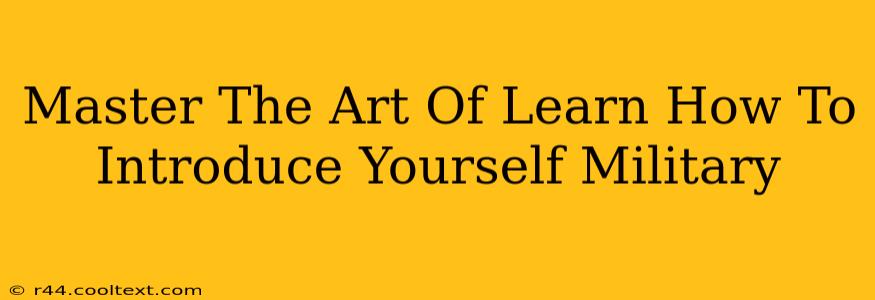Introducing yourself in the military isn't just about stating your name and rank; it's about projecting confidence, professionalism, and respect. It's a crucial skill that sets the tone for every interaction, from meeting your superiors to interacting with fellow service members. Mastering this seemingly simple act can significantly impact your military career and overall success. This guide will equip you with the knowledge and techniques to confidently introduce yourself in any military setting.
Understanding the Importance of Military Introductions
The military environment demands precision and clarity. A proper introduction demonstrates your understanding of military protocol and your commitment to upholding standards. It's the first impression you make, and first impressions matter. A strong, well-executed introduction conveys:
- Respect: You show respect for the person you're addressing, regardless of their rank.
- Professionalism: You present yourself as a competent and disciplined service member.
- Confidence: Your clear and concise introduction reflects self-assurance and competence.
- Composure: Even in high-pressure situations, a practiced introduction helps maintain composure.
The Essential Elements of a Military Introduction
A standard military introduction typically includes these elements:
- Salute (if appropriate): Saluting is a sign of respect and is essential when addressing senior officers. The specific rules for saluting vary depending on the branch and context.
- Rank and Name: State your rank clearly and follow it with your full name. For example: "Good morning, Sergeant Major, my name is Private John Smith." Always use the appropriate form of address for the recipient's rank.
- Unit (Optional): Adding your unit affiliation can be helpful, especially in larger formations. "Good morning, Sergeant Major, my name is Private John Smith, from the 1st Battalion."
- Purpose (Optional): Briefly state the reason for your introduction. For example, "Good morning, Sergeant Major, my name is Private John Smith, from the 1st Battalion. I'm here to report for duty."
Variations Based on Context
The specific wording of your introduction will vary depending on the situation. Here are a few examples:
- Meeting a superior officer: "Good morning/afternoon/evening, Sir/Ma'am. My name is Private John Smith, and I am here to..." (Remember to salute appropriately).
- Introducing yourself to a peer: A simple "Hello, my name is Private John Smith" is often sufficient. A handshake might also be appropriate depending on the circumstance.
- Formal settings: More formal introductions might be required for briefings or ceremonies.
Practicing and Refining Your Introduction
The key to mastering military introductions is practice. Practice introducing yourself in front of a mirror, with a friend, or even with your family. This helps you become comfortable and confident with the process.
Beyond the Basics: Body Language and Demeanor
Your body language and demeanor are just as important as the words you use. Maintain good posture, make eye contact, and speak clearly and concisely. Avoid fidgeting or appearing nervous. Your overall presentation should reflect professionalism and respect.
Conclusion: Making a Lasting Impression
Mastering the art of introducing yourself in the military is a valuable skill that will serve you throughout your career. By following these guidelines and practicing regularly, you can ensure that you make a strong and positive first impression every time. Remember, it's not just about the words you say, but the confidence and respect you convey with your entire demeanor.

